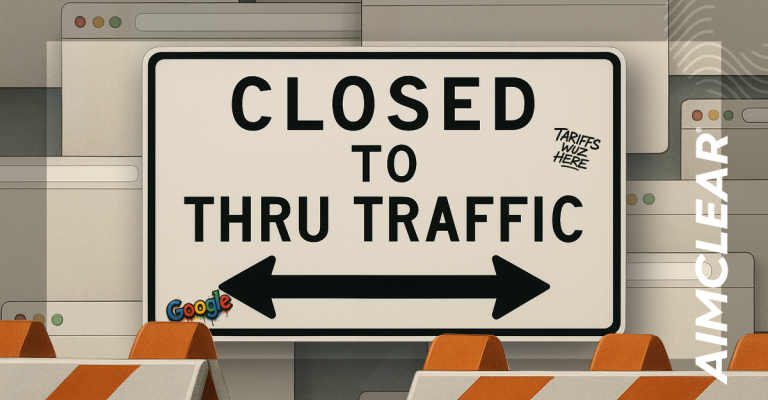
What should we do first? Who are the players? This session explored the “tactical demands of running a successful local/mobile search marketing campaign.”
Chris Sherman, Executive Editor, Search Engine Land , moderated and led off the discussion. Chris gave us the good news first, that “local and mobile campaigns have a lot in common with traditional search marketing. However, local mobile is much more fragmented with dozens or hundreds of factors to keep track of.”
Jenny Halasz, SEO Manager, Acronym Media was the next speaker to take the podium. First, she invited the audience to visit their corporate offices in the Empire State building, an offer I’m likely to take her up on.
Acronym Media’s concept gets back to tried and true keyword driven marketing to “harvest the power of user searches and provide relevant results.” She views planning for a local/mobile campaign as projecting possible progressions of a customer’s physical activity and gets granular. For instance, “Greg” arrives in NYC with his iPhone, searches for luxury hotels, tourist attractions, the best pizza, gets drunk and lost which leads to map searches (to get directions to back to the hotel). The next day he Googles airport limousines, etc…
Here are Jenny’s recommended steps in planning the campaign and be realistic:
Determine available financial resources and use simulators to better understand how the site currently renders via mobile.
Always include links back to the main HTML website.
Determine Your Resources.
If the budget is low, implement high impact low cost changes which can be made to existing campaigns. Submit to local networks, create an RSS feed, put business address in a single line text (the maps index single lines better), and apply for Google News inclusion to “build on the hyper-local web.” Also submit to Goog411.
If you have a bigger budget, consider creating a mobile specific site (m.site.com), create local- specific content about cities, regions, metro areas, etc… Consider paid ads in local engines and networks.
Best Practices
Jenny stressed that our visitors ARE mobile users! Offer basic mobile interaction aids, use tel-tags on phone numbers, add the area code or tool free prefix on phone numbers, be XHTM compliant, provide clear navigation, all pages should be no more than 3 clicks away from homepage, minimize the use of flash and images, minimize file sizes, use CSS and JS in external files. She recommends always using CSS and DIV tags to put navigation below content in the code and use mobile site maps.
Local search providers Acronym calls on include InfoSpace, Switchboard, Yahoo! Local, Google Maps, LiveSearch YellowPages.com AT&T SuperPages, and AOL Local. Jenny stressed that we should remember to check out smaller local niche’ players. International is also a tremendous opportunity including Baidu, Voila, Yahoo! Singapore, and Google France.
Chris Silver Smith, Lead Strategist, Netconcepts was up next. Chris suggested www.localsearchguide.org be the first stop for a guide of the top players in the local search field. The Local Search Guide is updated frequently to add new companies and reflect changes in the industry.
Status of the MarketPlace
Local and IYP are still strong. Their usage has been growing to some degree because they’ve expanded their utilities to include social media tools. Yahoo! Mobile search is growing, and we’re right on the cusp of matching Europe’s high usage. Local I.E. Yahoo Search now accounts for 24% of mobile Internet use. IYP users are closer to conversion in the buying process, 38% go on to make a purchase, are more targeted for the businesses they seek, and are more likely to have good income than users of general web media (100K+).
You Never Know Where Your Ad Might Show Up.
An idiosyncrasy of mobile search is that ads are often shared between platforms. Though mobile companies resist open platforms, tending to create “walled off gardens”, there is still some sharing as different providers feed into different mobile search providers. The trend is away from special mobile only display format to full webpage displays as a result of the iPhone. Usage and promotional potential is still lower than the regular internet but rapidly trending upward.
For small local businesses, getting a grip on this fragmentation is a consuming nightmare. For these businesses the key is to outsource the work to an agency or local search marketing firm to manage. For medium sized business with limited locations, moving some local search responsibilities in-house becomes possible, but he still recommends considering an agency. For large businesses with many locations it’s probably desirable to have full time employee(s) to manage the program, using various degrees of external agency involvement.
Chris reminds us to optimize for local search with traditional keyword research. Always make sure the “free-listing” level of placement is handled before staking out paid expenditures. Login and update/enhance your businesses listing with all of the local players like YellowPages.com, take ownership of your content and enhance it with as much extra as you can prior to paying.
Finally, he says to “approach mobile carefully” and “try to spread your promo efforts to as many places that have human eyes as possible without overwhelming your budget or ability to execute.”
Paul Bruemmer, Director Search Marketing Red Door Interactive, gave a presentation that was so deep in fast moving (and amazing statistics) that we’ll reserve a more detailed summary for later writings. Here are a few of the points he made:
Mobile ad spending Worldwide is 3 billion now (Source ABI research April 2007).
Mobile is the coming Web3.0
Projections are $11.35 billion by 2011
Some pros of mobile search marketing include:
Twice as many cell phones as PC’s
Web searches on mobile devices will someday exceed PCs
Access to international consumers who cannot afford PCs
Location specific
High click-through rates
The telephone number is still the best unique identifier ever invented.
Build the BEST customer db, loyalty marketing and customer retention is great.
Generate buzz for products and services
Reach consumers while actively shopping socializing and making buying decisions.
Behavioral targeting
Personal device people take with them wherever they go
Marketers can develop relationships
Carriers have customer data and location
Possible Cons of Mobile Search Marketing:
WAP general intolerance of advertising
Inadequate bandwidth which discourages searching
Still walled garden
Scarcity of mobile websites
SMX Speakers Resources:
Interviews with Chris Sherman
TopRank Interview with Chris Sherman of Search Engine Land and SMX
SearchNewz Interview with Chris Sherman of Third Door Media
btobOnline, Spotlight on Search: Interview with Chris Sherman of Third Door
Blog posts:
Search Marketing Now webcasts combine the most authoritative and actionable education about search engine marketing issues with the convenience of attending online.
Search Engine Land
—————————————————
Chris Silver Smith, Lead Strategist, Netconcepts
W. Chris Silver Smith, Artist, Writer & Technologist
Natural Search Blog
Local SEO For Retail Store Locators
Comparing Mobile Ads In Google & Yahoo
—————————————————
Jenny Halasz, SEO Manager, Acronym Media
LinkedIn Profile
—————————————————
Paul Bruemmer, Director Search Marketing, Red Door Interactive
LinkedIn Profile
Red Door Interactive
SEO Providers – Selecting a Reputable SEO Provider (Historical)








